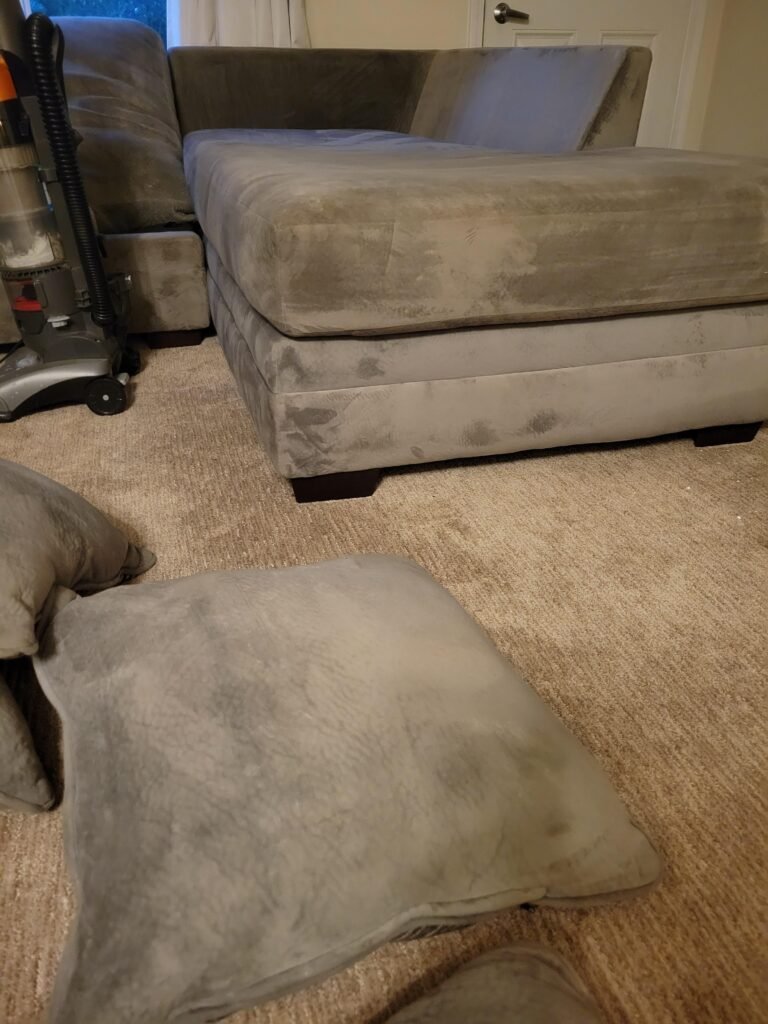As an Amazon Associate I earn from qualifying purchases.
Chiggers can live in furniture for several days. They thrive in warm, humid environments.
Understanding their lifespan helps manage and prevent infestations. Chiggers are tiny mites, almost invisible to the naked eye. They are notorious for their itchy bites. While they usually live outdoors, they can sometimes find their way inside. Knowing how long they can survive in furniture is crucial.
It helps in taking proper measures to get rid of them. In this blog post, we will explore the lifespan of chiggers in furniture. We’ll also discuss ways to keep your home chigger-free. Read on to learn more about these pesky creatures and how to protect your living space.
Life Cycle Of Chiggers
Understanding the life cycle of chiggers helps in managing them in furniture. Chiggers, also known as harvest mites, pass through several stages. Each stage impacts their survival and behavior.
Egg Stage
The life of a chigger starts as an egg. Female chiggers lay eggs in damp, shaded areas. These eggs are tiny and difficult to see. They hatch within a few days, releasing larvae.
Larval Stage
Larvae are the only stage that feeds on hosts. They attach to animals or humans, feeding on skin cells. This stage causes the most discomfort and itching. Larvae are red and have six legs.
After feeding, larvae drop off the host. They find a place to molt into nymphs. This process takes about one week.
Adult Stage
Adult chiggers do not feed on hosts. They live in soil and on plants. Adults are harmless to humans and pets.
They focus on reproducing and laying more eggs. This continues the cycle, leading to more larvae. Understanding each stage helps in controlling chiggers in furniture.
:max_bytes(150000):strip_icc()/What-are-chiggers-and-how-do-i-get-rid-of-them-5079919_color-7583e62e999b43f6bccb8d60cec4972a.jpg)
Credit: www.thespruce.com
Survival Of Chiggers In Furniture
Chiggers, tiny red mites, can cause severe itching and discomfort. Their survival in furniture depends on several factors. Understanding these factors can help you manage and prevent infestations.
Factors Affecting Chigger Survival
Chiggers need a warm and humid environment to thrive. Furniture in humid areas can support their survival longer. The type of fabric also matters. Natural fibers like cotton can provide a better habitat compared to synthetic materials.
Chiggers feed on skin cells and need a host to survive. Without a host, they can only live a few days. Regular cleaning can disrupt their environment, reducing their lifespan.
Common Hiding Spots In Furniture
Chiggers often hide in the seams and crevices of furniture. Upholstered furniture with thick padding can harbor more chiggers. They can also be found under cushions and in the folds of fabric.
They prefer dark, undisturbed areas. Checking and cleaning these spots can help in controlling their population.
Signs Of Chigger Infestation In Furniture
Chiggers are tiny pests that can cause big problems. They often hide in furniture, making it hard to spot them. Knowing the signs of a chigger infestation can help you take action quickly. Here’s what to look for in your furniture and how to identify symptoms in humans.
Symptoms In Humans
Chiggers leave noticeable marks on the skin. The bites are often red, itchy, and can become inflamed. Common areas for bites are the ankles, waist, and armpits. You may also notice small blisters or hives in the affected areas.
- Red, itchy bumps
- Blisters or hives
- Inflammation and swelling
Visible Indications In Furniture
Although chiggers are hard to see, there are signs they might be in your furniture. Look for tiny, red specks on cushions and fabric. These are often chiggers or their larvae. Another sign is unusual itching when sitting on the furniture, even if you can’t see the pests.
- Tiny, red specks on cushions
- Unusual itching when using the furniture
To be sure, you can use a magnifying glass to inspect the furniture. This can help you spot the tiny pests more easily.
| Sign | Description |
|---|---|
| Red specks | Possible chiggers or larvae on cushions |
| Itching | Unusual itching when sitting on furniture |
Recognizing these signs can help you address the problem swiftly. Stay vigilant and check your furniture often to keep these pests at bay.

Credit: www.barefootmosquito.com
Prevention And Removal Methods
Chiggers can be a nuisance in your furniture. Learning how to prevent and remove them is essential. There are several methods to keep your home chigger-free. Effective cleaning, using insecticides, and natural remedies can help.
Cleaning And Vacuuming
Regularly clean and vacuum your furniture. This helps remove chiggers and their eggs. Pay attention to cracks and crevices where chiggers might hide. Use a vacuum with a HEPA filter for best results. Dispose of the vacuum bag immediately after cleaning. Wash any removable fabric covers in hot water. This will kill any remaining chiggers.
Using Insecticides
Insecticides can be effective in getting rid of chiggers. Choose a product specifically designed for mites and chiggers. Follow the instructions on the label carefully. Spray the insecticide in areas where you suspect chiggers are present. Allow the furniture to dry completely before using it again. Keep pets and children away from treated areas until it is safe.
Natural Remedies
Natural remedies can also help remove chiggers from furniture. Diatomaceous earth is a popular choice. Sprinkle it on the furniture and leave it for a few hours. Then vacuum it up thoroughly. Essential oils like tea tree, lavender, and eucalyptus can repel chiggers. Mix a few drops with water and spray on the furniture. Regular use of these remedies can keep chiggers at bay.
Health Risks Associated With Chigger Infestation
Chigger infestations in furniture can pose several health risks. These tiny pests are not just a nuisance. They can cause serious discomfort and health issues. Understanding these risks is crucial for protecting your well-being.
Skin Irritation
Chigger bites can cause intense itching and redness. Their saliva contains enzymes that break down skin cells. This process triggers an immune response, leading to swelling and irritation. These bites often result in small, red bumps. The itching can last for days, making it hard to concentrate or sleep.
Secondary Infections
Scratching chigger bites can lead to secondary infections. When you scratch, you break the skin. This allows bacteria to enter and cause infections. Signs of infection include increased redness, warmth, and pus. If left untreated, these infections can become serious. Always clean and treat chigger bites promptly to avoid complications.

Credit: honorservices.com
Professional Help For Chigger Infestation
Chiggers are tiny but can cause big problems. They burrow into your furniture and make your life uncomfortable. If you have tried everything but still find no relief, it may be time to seek professional help. Experts can identify the extent of the infestation and use targeted treatments to eliminate these pests from your furniture.
When To Seek Professional Assistance
Sometimes, DIY methods are not enough. Here are signs you need professional help:
- You have tried home remedies, but chiggers keep coming back.
- You notice persistent itching and bites even after cleaning.
- There are visible signs of chiggers in multiple pieces of furniture.
- Your home has been infested for more than two weeks.
Professionals have the tools and knowledge to tackle severe infestations. They can offer long-term solutions, ensuring chiggers do not return.
Choosing Pest Control Services
Selecting the right pest control service is important. Here are tips to help you make the best choice:
- Experience: Choose a service with years of experience in dealing with chigger infestations.
- Reputation: Look for companies with good reviews and high ratings.
- Certification: Ensure the pest control company is certified and uses safe, eco-friendly methods.
- Guarantee: A reliable company will offer a guarantee on their services.
Comparing different services will help you find the most effective and affordable option. Professional help can save you time, money, and stress, ensuring your home becomes chigger-free.
Frequently Asked Questions
How Long Can Chiggers Live In Furniture?
Chiggers can survive in furniture for up to several weeks. They thrive in warm, humid environments. Regular cleaning can help eliminate them.
Can Chiggers Infest Indoor Furniture?
Yes, chiggers can infest indoor furniture. They may hitch a ride on pets or humans. Regular cleaning and vacuuming can prevent infestations.
How Do I Get Rid Of Chiggers In Furniture?
To get rid of chiggers, clean and vacuum furniture thoroughly. Use insecticides if necessary. Wash any fabrics or covers in hot water.
Can Chiggers Bite Me From Furniture?
Yes, chiggers can bite you from infested furniture. They latch onto skin and feed on fluids. Prompt cleaning can prevent this.
Conclusion
Chiggers in furniture can be a nuisance. They don’t live long, usually a few days. Cleaning your furniture helps eliminate them. Regular vacuuming and washing are key. Use hot water to wash fabrics. Always be vigilant for any signs of chiggers.
Preventing infestations is easier than treating them. Keep your home clean and tidy. This ensures comfort and peace of mind.
As an Amazon Associate, I earn from qualifying purchases.


